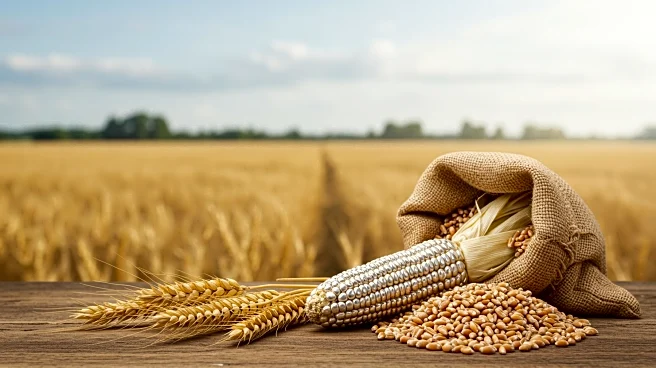What is the story about?
What's Happening?
The U.S. grain markets experienced mixed movements with December corn prices slightly increasing to $3.96¼ per bushel, while November soybeans rose by 6½¢ to $10.39¼ per bushel. According to Karl Setzer, partner with Consus Ag Consulting, the unexpected reduction in U.S. soybean stocks has provided significant support to the market, necessitating rationing of new crop inventory. Wheat prices showed varied changes, with September CBOT wheat rising by 2¢ to $5.07 per bushel, while September KC wheat decreased by ½¢ to $5.29½ per bushel. Additionally, livestock markets saw October live cattle prices increase by $2.50 to $231.52 per hundredweight, and September feeder cattle prices rose by $2.77 to $349.02 per hundredweight. Conversely, October lean hogs fell by 25¢ to $91.35 per hundredweight. The broader financial markets also reflected positive trends, with the S&P 500 Index up by 7.43 points and the Dow Jones Industrial Average increasing by 297.78 points.
Why It's Important?
The adjustments in soybean stocks are crucial as they influence the supply and demand dynamics within the agricultural sector, potentially affecting pricing and inventory strategies for farmers and traders. The mixed movements in grain prices highlight the volatility and complexity of agricultural markets, which can impact the economic stability of farming communities and related industries. The rise in cattle prices suggests a strong demand in the livestock sector, which could benefit ranchers and meat producers. Meanwhile, the decline in hog prices may indicate challenges in that segment. The overall positive performance of the stock market indices suggests investor confidence, which can have broader implications for economic growth and consumer spending.
What's Next?
Market participants will likely monitor further developments in crop production estimates and inventory levels, which could lead to additional price adjustments. The agricultural sector may need to adapt to changing supply conditions, potentially influencing planting decisions and resource allocation. Livestock producers might adjust their strategies based on price trends and demand forecasts. Financial markets will continue to react to economic indicators and geopolitical events, influencing investment strategies and economic outlooks.
Beyond the Headlines
The fluctuations in grain and livestock prices underscore the interconnectedness of global agricultural markets and the impact of environmental factors, such as weather conditions and crop diseases, on production and pricing. The need for efficient resource management and sustainable farming practices becomes increasingly important in maintaining market stability and ensuring food security.
AI Generated Content
Do you find this article useful?












